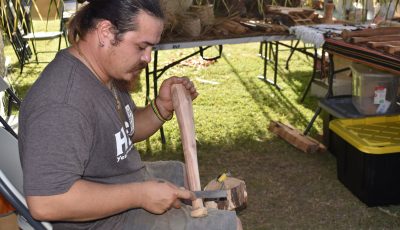EDITORIAL
The Flame Tree Arts Festival
The fire tree is the familiar red bloom towering over the kalachuchi and the plumeria, trees aflame with red flowers, abundantly prolific and growing profusely on either side of Mt. Tapuchao.
The flame trees on Saipan that are planted along Beach Road and Middle Road from Marpi to Obyan bloom from April to June and are used as the symbol this April 24 to 26 to gather the Flame Tree Arts Festival at the Civic Center in Susupe.
Who gets credit for bringing the tree to the islands—the Japanese in the islands’ sugarcane fields or a resident who intentionally brought many seedlings in the ’60s to plant—is immaterial. The arbor is the Commonwealth’s official tree.
The Flame Tree Arts Festival features luscious cuisine that delights the gourmet, accompanied by undulations of hip-and-thigh swaying dances and chants, with the loud resonance of electric guitars plucked and strummed to tropical beats, and the wildly colorful works of art from sculptures, wooden and stone, to Gauguin-like brightness on canvas.
The food is savored by appreciative palates, with flavors that include the source of carbohydrate in the Micronesian diet, the taro and the cassava. Singly consumed, they taste bland, though the discriminating taste buds finds comfort in it. But liberally sprinkled with spices served the same way as rice is ladled in Southeast Asian kitchens, they make olfactory and culinary essence a matter of choice. The popular asado, ubiquitous roasts and barbecue, of pork, beef, mutton and fish, are standards in Micronesian beach parties and utt celebrations.
The dances invite audience participation—for the male, foot stamping with a loud shout, thrusting the spear in hand and hitting the sand with the hilt, slapping the hip and thigh, raising an arm with clenched fist, and shrugging and lifting the shoulder; for the female, thrusting and swaying of the hips (often seen as sassy and cheeky) while still looking demure, and wearing the mwar-mwar with the elegance of the sleek outrigger cutting into ocean currents! The thumping bass percussion then is amplified in car music like crashing waves.
The visual arts render the festival a must-see occasion for all. Commercialized of late with fees charged for artists to put up tents and displays—much to the chagrin of amateurs just wanting to show off stunning works—we encourage organizers to ensure the broad visibility in the exhibit of pro and amateur wares.
Then there are the actual flame trees (also written as one word, flametrees), shading the pathway from Garapan to Susupe. Others are bare from the shortage of rain (though displaying long pods) but the walk on the pathway is an easy stride. Either way, with the eats and beats that is always a treat, the five-pronged flower and the plumeria are above-the-ear ladies’ ornaments, a sight always to behold. As you are, with tropical hat and sunshade, smartphone or camera, come feast at the festival! © 2015 Saipan Tribune



























